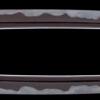No, i don't believe so, and on an famous Korean generals' blade, the true hamon was not aligned with the chiseled pattern. Some Vietnamese swords had real hamon, but mostly from smiths that were Japanese immigrants, especially some time during and or after Kato Kiyomasa's battles in South-East Asia and Korea. If what you asked was meant to be in application to Japanese blades specifically, I've never seen these engravings on them before that i still can recall or produce an example of, and am wanting to know if anyone else has.


